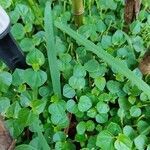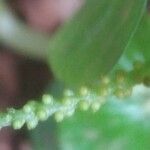Terrestrial herb, delicate, erect, glabrous, annual. Stem 10-30(-40) cm long, green often reddish tinged. Leaves alternate, basely attached; petiole to 0.3-2.5 cm long, glabrous; blade membranous, often drying translucent, broadly elliptic to deltoid, 1-3.7(-5) x 1-3.5(-5.5) cm, apex acute to obtuse, base rounded, cordulate or truncate; palmately 5-7-veined. Inflorescence terminal, solitary; peduncle slender, to 1 cm long, green; spike 1-6 cm long; densely flowered; floral bracts rounded, glabrous, minutely glandular. Fruits somewhat stipitate, globose, brown (young, green ones may be finely longitudinally ridged), stigma apical, a short style may be developed.
Herbs , annual or short-lived perennial, erect or decumbent, freely branched, 10-50 cm, glabrous, without black, glandular dots. Leaves alternate; petiole ca. 1/2 length of blade, glabrous. Leaf blade palmately 5-7-veined, broadly ovate to deltate, 0.6-4 × 0.5-3 cm, base truncate, rounded, or cordate, apex acute to slightly acuminate; surfaces glabrous. Spikes axillary, terminal, and opposite leaves, solitary, rarely 2-more, loosely flowered, 2-6 cm, mature fruiting spikes 1-2 mm diam. Fruits sessile, very broadly ovoid to globose, 0.5-0.7 × 0.4-0.5 mm, longitudinally ribbed with ladderlike reticulations; beak minute, conic, ca. 0.1 mm.
A rather delicate, erect, glabrous, pellucid, branched herb; stem up to 5 mm. thick near the base and 50 cm. tall; leaves alternate, round-deltoid-ovate, mostly 15-25 mm. wide, apex somewhat attenuate, acute, base subtruncate-cordate, palm-ately 5-nerved, drying very thin, semi-transparent; petiole mostly 1-2 cm. long, clasping-decurrent; spikes terminal, axillary, or leaf-opposed, slender, 2-5 cm. long, very loosely flowered; peduncle about 5 mm. long; bracts round-peltate; fruit about 0.8 mm. long, ellipsoidal, longitudinally more or less sulcately striate; apex pointed, stigma apical.
Herbs annual, fleshy, 20-40 cm high, all parts glabrous. Stems erect or ascending, branched, glabrous. Petiole 1-2 cm; leaf blade broadly ovate or ovate-triangular, length ± equal towidth, 1-3.5 cm, membranous, both surfaces glabrous, translucent, base cordate, apex acute or obtuse; veins 5-7. Spikes terminal or leaf-opposed, slender, 2-6 cm, glabrous, flowers lax;bracts suborbicular, ca. 0.5 mm wide, stalk short. Anthers sub-globose. Ovary ellipsoid; stigmas pubescent. Nutlet globose, ca. 0.5 mm in diam. Fl. Apr-Jul.
Erect, fleshy herb to 30 cm high. Leaves alternate; lamina ovate-elliptic, to 3.5 cm long, 3 cm wide, 5-veined; base rounded to cuneate; apex acute. Spike terminal or axillary in upper axils, solitary, to 7 cm long; peduncle 5–13 mm long; fertile axis 2–5 cm long. Flowers not sunken into axis, spaced 0.4–1 mm apart; bracts rounded, 0.3–0.4 mm long, 0.2–0.3 mm wide. Anthers oblong, c. 0.1 mm long, 0.1 mm wide. Ovary rounded-oblong, c. 0.3 mm long, 0.3 mm diam. Drupes sticky, papillose in ridges, 0.5–0.6 mm long.
A herb. It grows 10-30 cm tall. It grows from seed each year. The stems are thick and rounded. They are pale green and fleshy. The leaves have stalks. These are 1-2 cm long. The leaf blades are 0.8-3.5 cm long by 0.6-2.8 cm wide. They are oval and shiny pale green. The base is heart shaped. The flowers are yellow. They are very small and borne on a light green spike. This is produced at the end of a branch or opposite the leaves. The nutlet is round and 0.5 mm across.




